Topics
Category
Era
Sister Kenny Institute
The Sister Kenny Institute was founded in 1942 as a rehabilitation-based treatment center for polio patients. In the 1940s and 1950s, polio was one of the most widespread and dreaded childhood diseases in the world. Affected children and young adults traveled from across the globe to be treated by the Institute's founder, Australian nurse Elizabeth Kenny. The Institute also offered courses for nurses and physical therapists who wanted to be trained in the Kenny Method. After the polio vaccine was developed in 1955, the Sister Kenny Institute's mission expanded to include rehabilitation medicine in general.
Elizabeth Kenny was an unlikely figure to revolutionize the history of polio treatment. She was born in rural Australia in 1880. Although she had no formal training in nursing, she was able to talk her way into the Australian military and serve as a nurse. There she earned the title "Sister," an Australian military title given to the chief nurse.
Paralytic poliomyelitis, or polio, is a virus that can cause nerve damage in the spinal cord or brain stem. This damage usually caused signs of paralysis in a person's legs. It could also affect the arms, trunk, or diaphragm. Before Sister Kenny, doctors put splints and braces on affected limbs and occasionally operated. They used a respirator called an iron lung to help patients breathe.
When Sister Kenny saw her first case of polio in 1911, she thought the patients' limbs were stiff, not permanently paralyzed. She also was unaware of the accepted medical treatment. Instead of using braces to keep limbs rigid, she thought it was best to use hot packs and encourage gentle movement. Her method re-taught patients how to use limbs that had been only temporarily paralyzed by the virus. This revolutionized the treatment of polio.
Kenny faced a lot of resistance when she came to the United States in 1940. Doctors in New York and Chicago dismissed her. They did so because her theories challenged the conventional wisdom, and because she was a woman without much formal medical training. But in Minnesota, Kenny found an interested audience.
Kenny went to the Mayo Clinic and then the University of Minnesota. After demonstrating her treatments, she began caring for acute polio patients at Minneapolis General Hospital. Many parents wanted Sister Kenny to care for their children. Her treatment was more effective and less painful. Since she could not meet the demand, she began training technicians to help her.
Soon Sister Kenny and her technicians needed a larger facility. The Minneapolis Board of Public Welfare suggested the Lymanhurst building, which was being used as a school and hospital for children with rheumatic fever. The city relocated the patients and students who were there and remodeled it for Kenny's use.
The Elizabeth Kenny Clinic opened on December 17, 1942. The treatment methods that Sister Kenny used for polio—like heat packs and careful exercise—became the basis of a new field of medicine called rehabilitation medicine.
The hospital had a capacity of 100 beds, but it often served many more patients than that. During big epidemics, patients were sent to other hospitals in the city. In 1946, Minneapolis Mayor Hubert Humphrey pleaded with the federal government to let them temporarily use the barracks at Fort Snelling for polio patients.
Sister Kenny was very famous, and Hollywood made a movie about her. But the patients at the Kenny Institute had mixed feelings about their time at her clinic. They were young, sick, and scared. The Institute did not let them see their parents very often, and their rooms were overcrowded.
In 1943, the clinic became the Sister Kenny Institute and was managed and funded by the newly formed Sister Kenny Foundation. By the 1960s, the foundation and the institute were in trouble. The foundation's executive director, Marvin Kline, was indicted for mismanaging foundation funds.
After that crisis, Dr. Frank H. Krusen became the new director of the Sister Kenny Foundation. He restored community support, and his medical guidance kept the institute on the forefront of rehabilitation medicine even after the 1955 polio vaccine dramatically reduced the number of polio cases in the U.S.
In 1975, the Sister Kenny Institute united with the Abbott-Northwestern Hospital Corporation because it was becoming hard for small, freestanding hospitals to stay afloat. A 2013 merger with Courage Center (part of Allina Health) brought with it a new name: Courage Kenny Rehabilitation Institute.
Bibliography
Albertson, Don L. "Sister Kenny's Legacy." Hennepin History Magazine 37, no.1 (Spring 1978): 3–14.
Cohn, Victor. Sister Kenny: The Woman Who Challenged the Doctors. Minneapolis: University of Minnesota Press, 1975.
Sass, Edmund J., George Gottfried, Anthony Sorem, eds. Polio's Legacy: An Oral History. Lanham, MD: University Press of America, 1996.
Sister Elizabeth Kenny Foundation. The Story of the Sister Elizabeth Kenny Foundation in the Fight Against Polio. Minneapolis: Sister Elizabeth Kenny Foundation, 1950.
Related Resources
Primary
Elizabeth Kenny Papers, 1862–2001 (bulk 1942–1952)
Manuscript Collections, Minnesota Historical Society, St. Paul
http://www2.mnhs.org/library/findaids/00201.xml
Description: Personal papers documenting the life and career of an Australian nurse who discovered a revolutionary treatment for infantile paralysis and devoted her life to the dissemination of the treatment throughout the U.S. and abroad, as well as research files of two Kenny biographers. Also includes films, photographs, radio broadcasts, and magazine and newspaper clippings.
Janice Saunier Helland Papers, 1947–1951
Manuscript Collections, Minnesota Historical Society, St. Paul
Description: Correspondence and miscellaneous papers, photographs, and newspaper clippings of Janice Saunier Helland related to her work with Sister Elizabeth Kenny and the treatment of poliomyelitis.
James Ford Bell and Family Papers, 1861-1961
Manuscript Collections, Minnesota Historical Society, St. Paul
http://www2.mnhs.org/library/findaids/00749.xml
Description: Business and personal correspondence (1861-1961), newspaper clippings (1920-1961), print materials, scrapbooks, and miscellany of Bell, a Minneapolis flour-milling executive who was an active participant in public affairs, and other Bell family members. His papers include information on Sister Kenny's treatment program.
III.2
Abbott-Northwestern Hospital Photograph Collection (graphic), 1887–1981
Sound and Visual Collection, Minnesota Historical Society, St. Paul
Description: Photographs of exterior and interior views of hospital buildings and annexes, administrative and medical staff and their work in the hospital, adult, child and infant patient care, and nurses' training programs. Northwestern Hospital (founded 1882), Abbott Hospital (founded 1902) and Sister Kenny Institute (founded 1942) merged in the 1970s to form the Abbott-Northwestern Hospital Corporation, Minneapolis, Minn. Guide available with a list of the portraits of medical personnel and a published hospital history, filed in the Collections Container List notebooks in the Reading Room.
Pohl, John Florian M. The Kenny Concept of Infantile Paralysis and its Treatment.
Sister Kenny Institute. Publications and Audio-Visual Aids. Minneapolis: Sister Kenny Institute, 1973.
Sister Elizabeth Kenny Foundation. How the Elizabeth Kenny Institute Operates. Minneapolis: Division of Information Services, Sister Elizabeth Kenny Foundation, [1947?].
Sister Elizabeth Kenny Foundation. And They Shall Walk: If You Help! Minneapolis: Sister Elizabeth Kenny Foundation, 1945.
1546
Microfilm Collection, Minnesota Historical Society, St. Paul
Delano, Jack. Photographs of the Elizabeth Kenny Institute, Minneapolis, Minnesota, February 1943 microform: Infantile Paralysis Patients at the Institute... Washington, D.C.: Office of War Information, 1943.
Editor's note: These images are also available online, on the Library of Congress website. See web resources below.
Secondary
Cohn, Victor. "Sister Kenny's Fierce Fight for Better Polio Care." Smithsonian 12, no.8 (November 1981): 180–200.
Crofford, Emily. Healing Warrior: A Story about Sister Elizabeth Kenny. Minneapolis: Carolrhoda Books, 1989.
Oppewal, Sonda Riedesel. "Sister Elizabeth Kenny, an Australian Nurse, and Treatment of Poliomyelitis Victims." Journal of Nursing Scholarship 29, no.1 (March 1997): 83–88.
Trevelyan, Barry, Matthew Smallman-Raynor, and Andrew D. Cliff. "The Spatial Dynamics of Poliomyelitis in the United States: From Epidemic Emergence to Vaccine-Induced Retreat, 1910–1971." Annuals of the Association of American Geographers 95, no.2 (June 2005): 269–293.
http://www.ncbi.nlm.nih.gov/pmc/articles/PMC1473032/
Wilson, Daniel J. Living with Polio: The Epidemic and Its Survivors. Chicago: University of Chicago Press, 2005.
Web
Ampers. The Root Cellar: Sister Elizabeth Kenny & Doc Delmore.
Originally found at: http://www.ampers.org/pieces/root-cellar-sister-elizabeth-kenny-doc-delmore
The Minnesota Public Radio. Fighting Polio with "Gentle Hands."
http://news.minnesota.publicradio.org/features/200208/22_olsond_sisterkinney/index.shtml
Minnesota Historical Society. History Topics: Sister Elizabeth Kenny.
http://libguides.mnhs.org/sisterkenny
Allina Medical. Sister Kenny Rehabilitation Institute.
http://www.allinahealth.org/Courage-Kenny-Rehabilitation-Institute/
The Library of Congress. Search for Sister Kenny in the Prints and Photographs Collection.
http://www.loc.gov/pictures/search/?q=sister%20kenny&co=fsa
Related Video
Sister Kenny
Video about Australian nurse Elizabeth Kenny, founder of the Sister Kenny Institute, created by the Minnesota Historical Society, May 22, 2012.
All rights reserved
Articles
Related Audio
Sister Kenny's Polio Solution
In this brief radio documentary, MN90 producer Andi McDaniel learns how Aussie-Minnesotan Elizabeth Kenny revolutionized polio care.
All rights reserved
Holding Location
More Information
Articles
Related Images
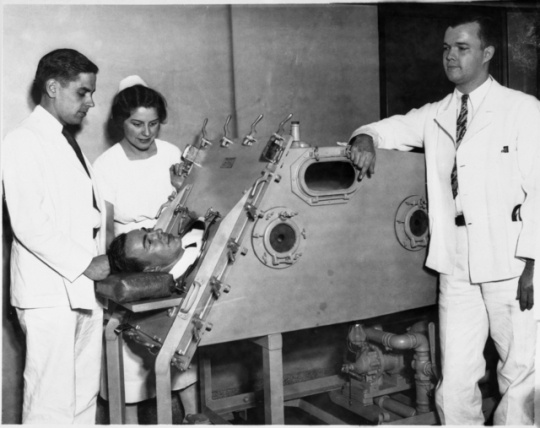
Iron lung patient and staff, Sister Kenny Institute, Minneapolis
Iron lung patient and staff, Sister Kenny Institute, Minneapolis. c.1942.
Holding Location
Articles
More Information
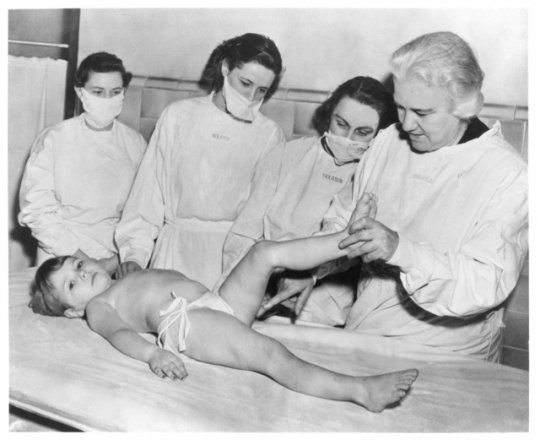
Sister Kenny demonstrates her therapy techniques
Sister Kenny demonstrates her therapy techniques, c.1942. Her pioneering physical therapeutic approach to polio first received a positive response at the University of Minnesota and later shaped the standard treatment for polio.
Holding Location
More Information
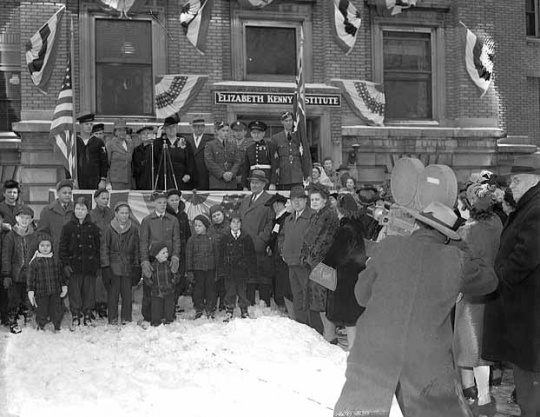
Dedication ceremony, Elizabeth Kenny Institute, 1800 Chicago, Minneapolis
Dedication ceremony, Elizabeth Kenny Institute, 1800 Chicago, Minneapolis. 12/17/1942.
Holding Location
Articles
More Information
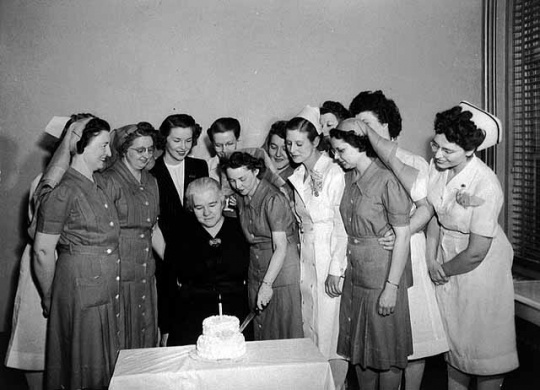
Sister Kenny Institute staff help Sister Kenny celebrate Institute's first birthday
Sister Kenny Institute staff helps Sister Kenny celebrate Institute's first birthday. December 1943.
Holding Location
Articles
More Information
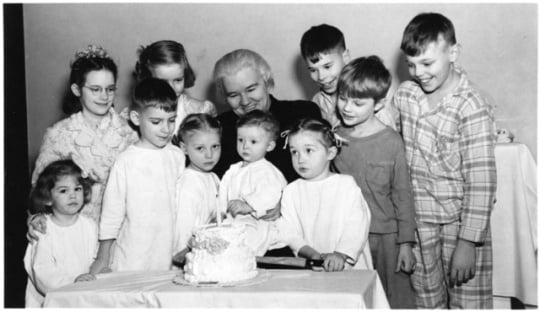
Sister Kenny Institute polio patients help Sister Kenny celebrate Institute's first birthday
Sister Kenny Institute polio patients help Sister Kenny celebrate Institute's first birthday. December 1943.
Holding Location
Articles
More Information
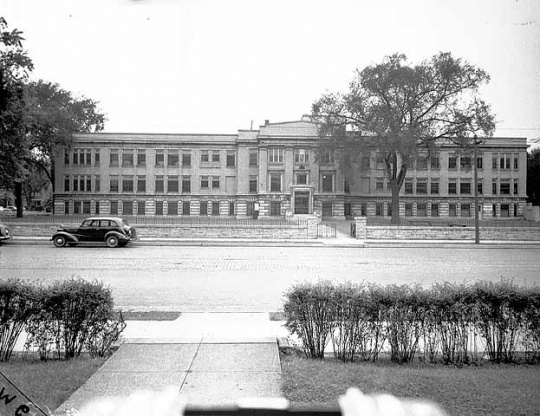
Elizabeth Kenny Institute, 1800 Chicago, Minneapolis
Elizabeth Kenny Institute, 1800 Chicago, Minneapolis. c.1943.
Holding Location
Articles
More Information
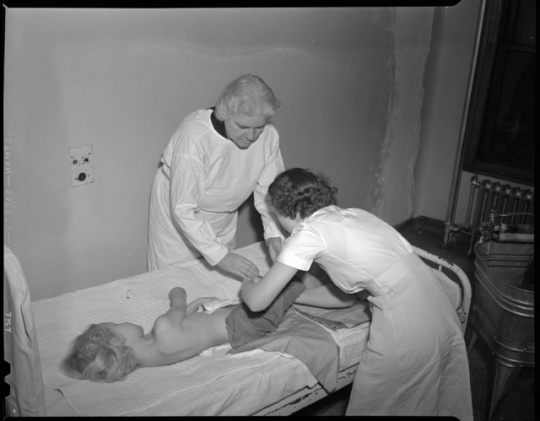
Sister Elizabeth Kenny examining a child and lecturing to visitors
Sister Elizabeth Kenny examining a child and lecturing to visitors c.1945.
Holding Location
Articles
More Information
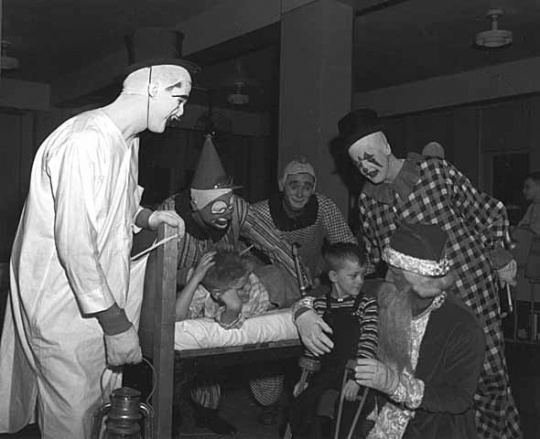
Aqua Jesters visiting Sister Kenny Institute, Minneapolis
Aqua Jesters visiting Sister Kenny Institute, Minneapolis, December 1947.
Holding Location
Articles
More Information
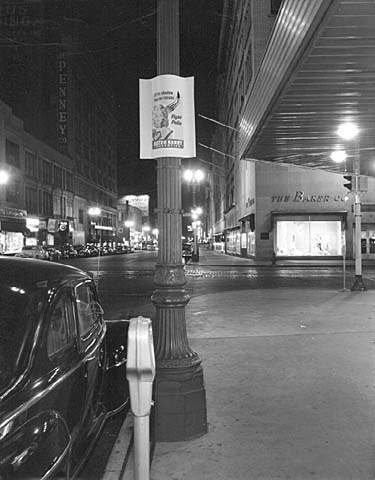
"Fight Polio" poster for Sister Kenny Institute on light pole, downtown Minneapolis
"Fight Polio" poster for Sister Kenny Institute on light pole, downtown Minneapolis. 1950.
Holding Location
Articles
More Information
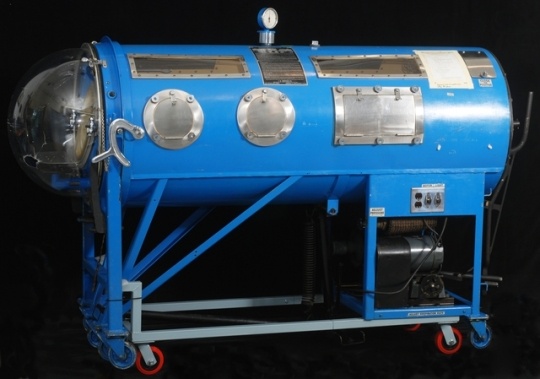
Iron lung used at Kenny Institute
Iron lung used at Kenny Institute. 'The Emerson Respirator' manufactured by the J.H. Emerson Co., Cambridge 40, MA, 1953. Juvenile size iron lung used at Sister Kenny Institute, Minneapolis, to treat polio patients.
All rights reserved
Holding Location
Articles
More Information
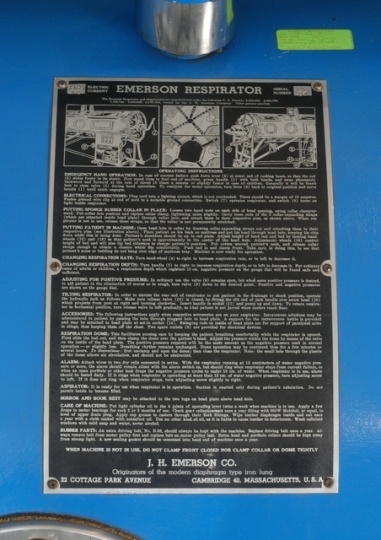
Iron lung used at Kenny Institute
Iron lung used at Kenny Institute. 'The Emerson Respirator' manufactured by the J.H. Emerson Co., Cambridge 40, MA, 1953. Juvenile size iron lung used at Sister Kenny Institute, Minneapolis, to treat polio patients.
All rights reserved
Holding Location
Articles
More Information
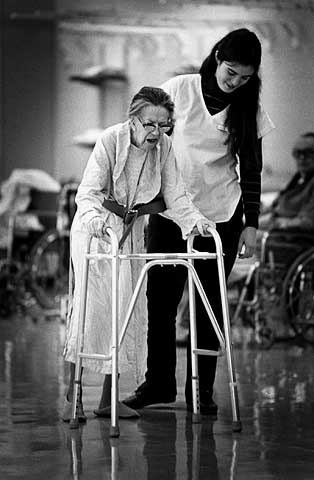
Therapist assists elderly stroke victim with a walker, Abbott-Northwestern Hospital, Sister Kenny Pavilion
Therapist assists elderly stroke patient with a walker, Abbott-Northwestern Hospital, Sister Kenny Pavilion. 2/21/1981.
Holding Location
Articles
More Information
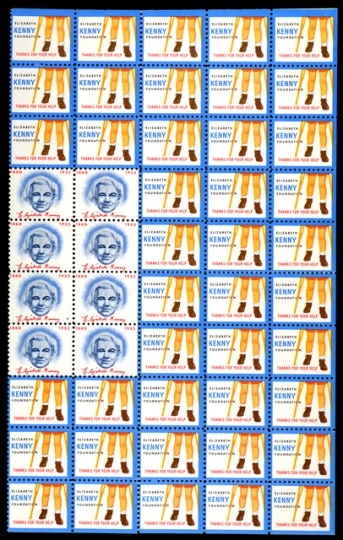
Seals, Sister Kenny Foundation
Sister Kenny Foundation seals used for fundraising campaign, 3 different presentations, date unknown.
All rights reserved
Holding Location
Articles
More Information
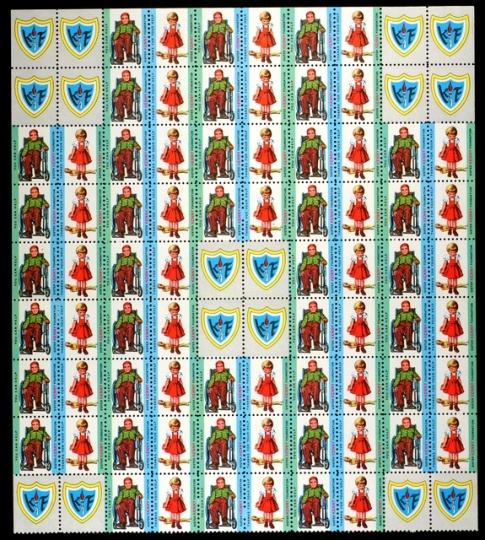
Seals, Sister Kenny Foundation
Sister Kenny Foundation seals used for fundraising campaign, 3 different presentations, date unknown.
All rights reserved
Holding Location
Articles
More Information
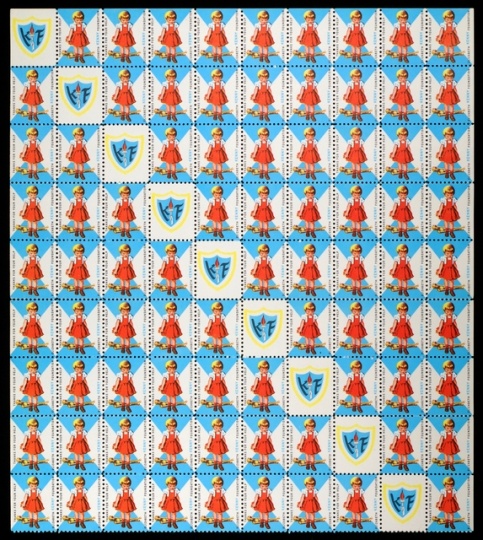
Seals, Sister Kenny Foundation
Sister Kenny Foundation seals used for fundraising campaign, 3 different presentations, date unknown.
All rights reserved
Holding Location
Articles
More Information
Related Articles
Turning Point
The Elizabeth Kenny Clinic opens on December 17, 1942. The hospital treats children with polio using Sister Kenny's groundbreaking techniques of physical rehabilitation.
Chronology
1880
1931
1940
1942
1943
1952
1955
1960
1975
2013
Bibliography
Albertson, Don L. "Sister Kenny's Legacy." Hennepin History Magazine 37, no.1 (Spring 1978): 3–14.
Cohn, Victor. Sister Kenny: The Woman Who Challenged the Doctors. Minneapolis: University of Minnesota Press, 1975.
Sass, Edmund J., George Gottfried, Anthony Sorem, eds. Polio's Legacy: An Oral History. Lanham, MD: University Press of America, 1996.
Sister Elizabeth Kenny Foundation. The Story of the Sister Elizabeth Kenny Foundation in the Fight Against Polio. Minneapolis: Sister Elizabeth Kenny Foundation, 1950.
Related Resources
Primary
Elizabeth Kenny Papers, 1862–2001 (bulk 1942–1952)
Manuscript Collections, Minnesota Historical Society, St. Paul
http://www2.mnhs.org/library/findaids/00201.xml
Description: Personal papers documenting the life and career of an Australian nurse who discovered a revolutionary treatment for infantile paralysis and devoted her life to the dissemination of the treatment throughout the U.S. and abroad, as well as research files of two Kenny biographers. Also includes films, photographs, radio broadcasts, and magazine and newspaper clippings.
Janice Saunier Helland Papers, 1947–1951
Manuscript Collections, Minnesota Historical Society, St. Paul
Description: Correspondence and miscellaneous papers, photographs, and newspaper clippings of Janice Saunier Helland related to her work with Sister Elizabeth Kenny and the treatment of poliomyelitis.
James Ford Bell and Family Papers, 1861-1961
Manuscript Collections, Minnesota Historical Society, St. Paul
http://www2.mnhs.org/library/findaids/00749.xml
Description: Business and personal correspondence (1861-1961), newspaper clippings (1920-1961), print materials, scrapbooks, and miscellany of Bell, a Minneapolis flour-milling executive who was an active participant in public affairs, and other Bell family members. His papers include information on Sister Kenny's treatment program.
III.2
Abbott-Northwestern Hospital Photograph Collection (graphic), 1887–1981
Sound and Visual Collection, Minnesota Historical Society, St. Paul
Description: Photographs of exterior and interior views of hospital buildings and annexes, administrative and medical staff and their work in the hospital, adult, child and infant patient care, and nurses' training programs. Northwestern Hospital (founded 1882), Abbott Hospital (founded 1902) and Sister Kenny Institute (founded 1942) merged in the 1970s to form the Abbott-Northwestern Hospital Corporation, Minneapolis, Minn. Guide available with a list of the portraits of medical personnel and a published hospital history, filed in the Collections Container List notebooks in the Reading Room.
Pohl, John Florian M. The Kenny Concept of Infantile Paralysis and its Treatment.
Sister Kenny Institute. Publications and Audio-Visual Aids. Minneapolis: Sister Kenny Institute, 1973.
Sister Elizabeth Kenny Foundation. How the Elizabeth Kenny Institute Operates. Minneapolis: Division of Information Services, Sister Elizabeth Kenny Foundation, [1947?].
Sister Elizabeth Kenny Foundation. And They Shall Walk: If You Help! Minneapolis: Sister Elizabeth Kenny Foundation, 1945.
1546
Microfilm Collection, Minnesota Historical Society, St. Paul
Delano, Jack. Photographs of the Elizabeth Kenny Institute, Minneapolis, Minnesota, February 1943 microform: Infantile Paralysis Patients at the Institute... Washington, D.C.: Office of War Information, 1943.
Editor's note: These images are also available online, on the Library of Congress website. See web resources below.
Secondary
Cohn, Victor. "Sister Kenny's Fierce Fight for Better Polio Care." Smithsonian 12, no.8 (November 1981): 180–200.
Crofford, Emily. Healing Warrior: A Story about Sister Elizabeth Kenny. Minneapolis: Carolrhoda Books, 1989.
Oppewal, Sonda Riedesel. "Sister Elizabeth Kenny, an Australian Nurse, and Treatment of Poliomyelitis Victims." Journal of Nursing Scholarship 29, no.1 (March 1997): 83–88.
Trevelyan, Barry, Matthew Smallman-Raynor, and Andrew D. Cliff. "The Spatial Dynamics of Poliomyelitis in the United States: From Epidemic Emergence to Vaccine-Induced Retreat, 1910–1971." Annuals of the Association of American Geographers 95, no.2 (June 2005): 269–293.
http://www.ncbi.nlm.nih.gov/pmc/articles/PMC1473032/
Wilson, Daniel J. Living with Polio: The Epidemic and Its Survivors. Chicago: University of Chicago Press, 2005.
Web
Ampers. The Root Cellar: Sister Elizabeth Kenny & Doc Delmore.
Originally found at: http://www.ampers.org/pieces/root-cellar-sister-elizabeth-kenny-doc-delmore
The Minnesota Public Radio. Fighting Polio with "Gentle Hands."
http://news.minnesota.publicradio.org/features/200208/22_olsond_sisterkinney/index.shtml
Minnesota Historical Society. History Topics: Sister Elizabeth Kenny.
http://libguides.mnhs.org/sisterkenny
Allina Medical. Sister Kenny Rehabilitation Institute.
http://www.allinahealth.org/Courage-Kenny-Rehabilitation-Institute/
The Library of Congress. Search for Sister Kenny in the Prints and Photographs Collection.
http://www.loc.gov/pictures/search/?q=sister%20kenny&co=fsa

















